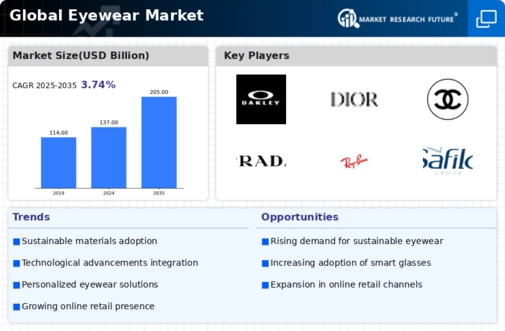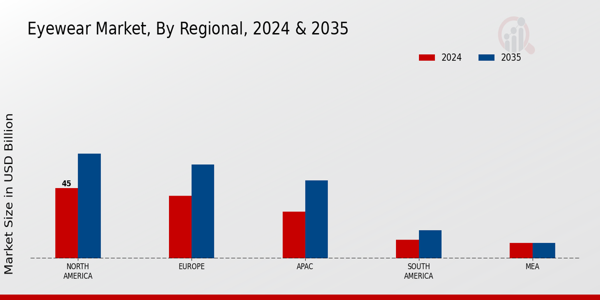- Eyewear Market By Product Type (USD Billion, 2019-2035)
- Prescription Glasses
- Sunglasses
- Reading Glasses
- Contact Lenses
- Safety Glasses
- Eyewear Market By Material (USD Billion, 2019-2035)
- Plastic
- Metal
- Glass
- Composite
- Wood
- Eyewear Market By End User (USD Billion, 2019-2035)
- Eyewear Market By Distribution Channel (USD Billion, 2019-2035)
- Online Retail
- Offline Retail
- Optical Stores
- Department Stores
- Eyewear Market By Regional (USD Billion, 2019-2035)
- North America
- Europe
- South America
- Asia Pacific
- Middle East and Africa
North America Outlook (USD Billion, 2019-2035)
North America Eyewear Market by Product Type
Prescription Glasses
Sunglasses
Reading Glasses
Contact Lenses
Safety Glasses
North America Eyewear Market by Material Type
Plastic
Metal
Glass
Composite
Wood
North America Eyewear Market by End User Type
Men
Women
Children
Unisex
North America Eyewear Market by Distribution Channel Type
Online Retail
Offline Retail
Optical Stores
Department Stores
North America Eyewear Market by Regional Type
US
Canada
US Outlook (USD Billion, 2019-2035)
US Eyewear Market by Product Type
Prescription Glasses
Sunglasses
Reading Glasses
Contact Lenses
Safety Glasses
US Eyewear Market by Material Type
Plastic
Metal
Glass
Composite
Wood
US Eyewear Market by End User Type
Men
Women
Children
Unisex
US Eyewear Market by Distribution Channel Type
Online Retail
Offline Retail
Optical Stores
Department Stores
CANADA Outlook (USD Billion, 2019-2035)
CANADA Eyewear Market by Product Type
Prescription Glasses
Sunglasses
Reading Glasses
Contact Lenses
Safety Glasses
CANADA Eyewear Market by Material Type
Plastic
Metal
Glass
Composite
Wood
CANADA Eyewear Market by End User Type
Men
Women
Children
Unisex
CANADA Eyewear Market by Distribution Channel Type
Online Retail
Offline Retail
Optical Stores
Department Stores
Europe Outlook (USD Billion, 2019-2035)
Europe Eyewear Market by Product Type
Prescription Glasses
Sunglasses
Reading Glasses
Contact Lenses
Safety Glasses
Europe Eyewear Market by Material Type
Plastic
Metal
Glass
Composite
Wood
Europe Eyewear Market by End User Type
Men
Women
Children
Unisex
Europe Eyewear Market by Distribution Channel Type
Online Retail
Offline Retail
Optical Stores
Department Stores
Europe Eyewear Market by Regional Type
Germany
UK
France
Russia
Italy
Spain
Rest of Europe
GERMANY Outlook (USD Billion, 2019-2035)
GERMANY Eyewear Market by Product Type
Prescription Glasses
Sunglasses
Reading Glasses
Contact Lenses
Safety Glasses
GERMANY Eyewear Market by Material Type
Plastic
Metal
Glass
Composite
Wood
GERMANY Eyewear Market by End User Type
Men
Women
Children
Unisex
GERMANY Eyewear Market by Distribution Channel Type
Online Retail
Offline Retail
Optical Stores
Department Stores
UK Outlook (USD Billion, 2019-2035)
UK Eyewear Market by Product Type
Prescription Glasses
Sunglasses
Reading Glasses
Contact Lenses
Safety Glasses
UK Eyewear Market by Material Type
Plastic
Metal
Glass
Composite
Wood
UK Eyewear Market by End User Type
Men
Women
Children
Unisex
UK Eyewear Market by Distribution Channel Type
Online Retail
Offline Retail
Optical Stores
Department Stores
FRANCE Outlook (USD Billion, 2019-2035)
FRANCE Eyewear Market by Product Type
Prescription Glasses
Sunglasses
Reading Glasses
Contact Lenses
Safety Glasses
FRANCE Eyewear Market by Material Type
Plastic
Metal
Glass
Composite
Wood
FRANCE Eyewear Market by End User Type
Men
Women
Children
Unisex
FRANCE Eyewear Market by Distribution Channel Type
Online Retail
Offline Retail
Optical Stores
Department Stores
RUSSIA Outlook (USD Billion, 2019-2035)
RUSSIA Eyewear Market by Product Type
Prescription Glasses
Sunglasses
Reading Glasses
Contact Lenses
Safety Glasses
RUSSIA Eyewear Market by Material Type
Plastic
Metal
Glass
Composite
Wood
RUSSIA Eyewear Market by End User Type
Men
Women
Children
Unisex
RUSSIA Eyewear Market by Distribution Channel Type
Online Retail
Offline Retail
Optical Stores
Department Stores
ITALY Outlook (USD Billion, 2019-2035)
ITALY Eyewear Market by Product Type
Prescription Glasses
Sunglasses
Reading Glasses
Contact Lenses
Safety Glasses
ITALY Eyewear Market by Material Type
Plastic
Metal
Glass
Composite
Wood
ITALY Eyewear Market by End User Type
Men
Women
Children
Unisex
ITALY Eyewear Market by Distribution Channel Type
Online Retail
Offline Retail
Optical Stores
Department Stores
SPAIN Outlook (USD Billion, 2019-2035)
SPAIN Eyewear Market by Product Type
Prescription Glasses
Sunglasses
Reading Glasses
Contact Lenses
Safety Glasses
SPAIN Eyewear Market by Material Type
Plastic
Metal
Glass
Composite
Wood
SPAIN Eyewear Market by End User Type
Men
Women
Children
Unisex
SPAIN Eyewear Market by Distribution Channel Type
Online Retail
Offline Retail
Optical Stores
Department Stores
REST OF EUROPE Outlook (USD Billion, 2019-2035)
REST OF EUROPE Eyewear Market by Product Type
Prescription Glasses
Sunglasses
Reading Glasses
Contact Lenses
Safety Glasses
REST OF EUROPE Eyewear Market by Material Type
Plastic
Metal
Glass
Composite
Wood
REST OF EUROPE Eyewear Market by End User Type
Men
Women
Children
Unisex
REST OF EUROPE Eyewear Market by Distribution Channel Type
Online Retail
Offline Retail
Optical Stores
Department Stores
APAC Outlook (USD Billion, 2019-2035)
APAC Eyewear Market by Product Type
Prescription Glasses
Sunglasses
Reading Glasses
Contact Lenses
Safety Glasses
APAC Eyewear Market by Material Type
Plastic
Metal
Glass
Composite
Wood
APAC Eyewear Market by End User Type
Men
Women
Children
Unisex
APAC Eyewear Market by Distribution Channel Type
Online Retail
Offline Retail
Optical Stores
Department Stores
APAC Eyewear Market by Regional Type
China
India
Japan
South Korea
Malaysia
Thailand
Indonesia
Rest of APAC
CHINA Outlook (USD Billion, 2019-2035)
CHINA Eyewear Market by Product Type
Prescription Glasses
Sunglasses
Reading Glasses
Contact Lenses
Safety Glasses
CHINA Eyewear Market by Material Type
Plastic
Metal
Glass
Composite
Wood
CHINA Eyewear Market by End User Type
Men
Women
Children
Unisex
CHINA Eyewear Market by Distribution Channel Type
Online Retail
Offline Retail
Optical Stores
Department Stores
INDIA Outlook (USD Billion, 2019-2035)
INDIA Eyewear Market by Product Type
Prescription Glasses
Sunglasses
Reading Glasses
Contact Lenses
Safety Glasses
INDIA Eyewear Market by Material Type
Plastic
Metal
Glass
Composite
Wood
INDIA Eyewear Market by End User Type
Men
Women
Children
Unisex
INDIA Eyewear Market by Distribution Channel Type
Online Retail
Offline Retail
Optical Stores
Department Stores
JAPAN Outlook (USD Billion, 2019-2035)
JAPAN Eyewear Market by Product Type
Prescription Glasses
Sunglasses
Reading Glasses
Contact Lenses
Safety Glasses
JAPAN Eyewear Market by Material Type
Plastic
Metal
Glass
Composite
Wood
JAPAN Eyewear Market by End User Type
Men
Women
Children
Unisex
JAPAN Eyewear Market by Distribution Channel Type
Online Retail
Offline Retail
Optical Stores
Department Stores
SOUTH KOREA Outlook (USD Billion, 2019-2035)
SOUTH KOREA Eyewear Market by Product Type
Prescription Glasses
Sunglasses
Reading Glasses
Contact Lenses
Safety Glasses
SOUTH KOREA Eyewear Market by Material Type
Plastic
Metal
Glass
Composite
Wood
SOUTH KOREA Eyewear Market by End User Type
Men
Women
Children
Unisex
SOUTH KOREA Eyewear Market by Distribution Channel Type
Online Retail
Offline Retail
Optical Stores
Department Stores
MALAYSIA Outlook (USD Billion, 2019-2035)
MALAYSIA Eyewear Market by Product Type
Prescription Glasses
Sunglasses
Reading Glasses
Contact Lenses
Safety Glasses
MALAYSIA Eyewear Market by Material Type
Plastic
Metal
Glass
Composite
Wood
MALAYSIA Eyewear Market by End User Type
Men
Women
Children
Unisex
MALAYSIA Eyewear Market by Distribution Channel Type
Online Retail
Offline Retail
Optical Stores
Department Stores
THAILAND Outlook (USD Billion, 2019-2035)
THAILAND Eyewear Market by Product Type
Prescription Glasses
Sunglasses
Reading Glasses
Contact Lenses
Safety Glasses
THAILAND Eyewear Market by Material Type
Plastic
Metal
Glass
Composite
Wood
THAILAND Eyewear Market by End User Type
Men
Women
Children
Unisex
THAILAND Eyewear Market by Distribution Channel Type
Online Retail
Offline Retail
Optical Stores
Department Stores
INDONESIA Outlook (USD Billion, 2019-2035)
INDONESIA Eyewear Market by Product Type
Prescription Glasses
Sunglasses
Reading Glasses
Contact Lenses
Safety Glasses
INDONESIA Eyewear Market by Material Type
Plastic
Metal
Glass
Composite
Wood
INDONESIA Eyewear Market by End User Type
Men
Women
Children
Unisex
INDONESIA Eyewear Market by Distribution Channel Type
Online Retail
Offline Retail
Optical Stores
Department Stores
REST OF APAC Outlook (USD Billion, 2019-2035)
REST OF APAC Eyewear Market by Product Type
Prescription Glasses
Sunglasses
Reading Glasses
Contact Lenses
Safety Glasses
REST OF APAC Eyewear Market by Material Type
Plastic
Metal
Glass
Composite
Wood
REST OF APAC Eyewear Market by End User Type
Men
Women
Children
Unisex
REST OF APAC Eyewear Market by Distribution Channel Type
Online Retail
Offline Retail
Optical Stores
Department Stores
South America Outlook (USD Billion, 2019-2035)
South America Eyewear Market by Product Type
Prescription Glasses
Sunglasses
Reading Glasses
Contact Lenses
Safety Glasses
South America Eyewear Market by Material Type
Plastic
Metal
Glass
Composite
Wood
South America Eyewear Market by End User Type
Men
Women
Children
Unisex
South America Eyewear Market by Distribution Channel Type
Online Retail
Offline Retail
Optical Stores
Department Stores
South America Eyewear Market by Regional Type
Brazil
Mexico
Argentina
Rest of South America
BRAZIL Outlook (USD Billion, 2019-2035)
BRAZIL Eyewear Market by Product Type
Prescription Glasses
Sunglasses
Reading Glasses
Contact Lenses
Safety Glasses
BRAZIL Eyewear Market by Material Type
Plastic
Metal
Glass
Composite
Wood
BRAZIL Eyewear Market by End User Type
Men
Women
Children
Unisex
BRAZIL Eyewear Market by Distribution Channel Type
Online Retail
Offline Retail
Optical Stores
Department Stores
MEXICO Outlook (USD Billion, 2019-2035)
MEXICO Eyewear Market by Product Type
Prescription Glasses
Sunglasses
Reading Glasses
Contact Lenses
Safety Glasses
MEXICO Eyewear Market by Material Type
Plastic
Metal
Glass
Composite
Wood
MEXICO Eyewear Market by End User Type
Men
Women
Children
Unisex
MEXICO Eyewear Market by Distribution Channel Type
Online Retail
Offline Retail
Optical Stores
Department Stores
ARGENTINA Outlook (USD Billion, 2019-2035)
ARGENTINA Eyewear Market by Product Type
Prescription Glasses
Sunglasses
Reading Glasses
Contact Lenses
Safety Glasses
ARGENTINA Eyewear Market by Material Type
Plastic
Metal
Glass
Composite
Wood
ARGENTINA Eyewear Market by End User Type
Men
Women
Children
Unisex
ARGENTINA Eyewear Market by Distribution Channel Type
Online Retail
Offline Retail
Optical Stores
Department Stores
REST OF SOUTH AMERICA Outlook (USD Billion, 2019-2035)
REST OF SOUTH AMERICA Eyewear Market by Product Type
Prescription Glasses
Sunglasses
Reading Glasses
Contact Lenses
Safety Glasses
REST OF SOUTH AMERICA Eyewear Market by Material Type
Plastic
Metal
Glass
Composite
Wood
REST OF SOUTH AMERICA Eyewear Market by End User Type
Men
Women
Children
Unisex
REST OF SOUTH AMERICA Eyewear Market by Distribution Channel Type
Online Retail
Offline Retail
Optical Stores
Department Stores
MEA Outlook (USD Billion, 2019-2035)
MEA Eyewear Market by Product Type
Prescription Glasses
Sunglasses
Reading Glasses
Contact Lenses
Safety Glasses
MEA Eyewear Market by Material Type
Plastic
Metal
Glass
Composite
Wood
MEA Eyewear Market by End User Type
Men
Women
Children
Unisex
MEA Eyewear Market by Distribution Channel Type
Online Retail
Offline Retail
Optical Stores
Department Stores
MEA Eyewear Market by Regional Type
GCC Countries
South Africa
Rest of MEA
GCC COUNTRIES Outlook (USD Billion, 2019-2035)
GCC COUNTRIES Eyewear Market by Product Type
Prescription Glasses
Sunglasses
Reading Glasses
Contact Lenses
Safety Glasses
GCC COUNTRIES Eyewear Market by Material Type
Plastic
Metal
Glass
Composite
Wood
GCC COUNTRIES Eyewear Market by End User Type
Men
Women
Children
Unisex
GCC COUNTRIES Eyewear Market by Distribution Channel Type
Online Retail
Offline Retail
Optical Stores
Department Stores
SOUTH AFRICA Outlook (USD Billion, 2019-2035)
SOUTH AFRICA Eyewear Market by Product Type
Prescription Glasses
Sunglasses
Reading Glasses
Contact Lenses
Safety Glasses
SOUTH AFRICA Eyewear Market by Material Type
Plastic
Metal
Glass
Composite
Wood
SOUTH AFRICA Eyewear Market by End User Type
Men
Women
Children
Unisex
SOUTH AFRICA Eyewear Market by Distribution Channel Type
Online Retail
Offline Retail
Optical Stores
Department Stores
REST OF MEA Outlook (USD Billion, 2019-2035)
REST OF MEA Eyewear Market by Product Type
Prescription Glasses
Sunglasses
Reading Glasses
Contact Lenses
Safety Glasses
REST OF MEA Eyewear Market by Material Type
Plastic
Metal
Glass
Composite
Wood
REST OF MEA Eyewear Market by End User Type
Men
Women
Children
Unisex
REST OF MEA Eyewear Market by Distribution Channel Type
Online Retail
Offline Retail
Optical Stores
Department Stores


















Leave a Comment